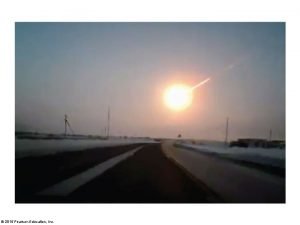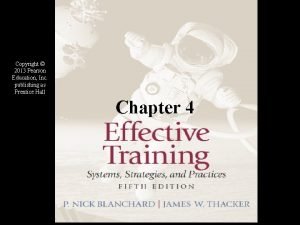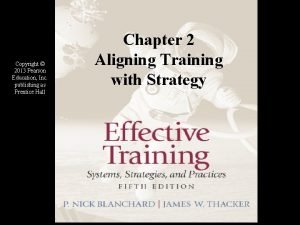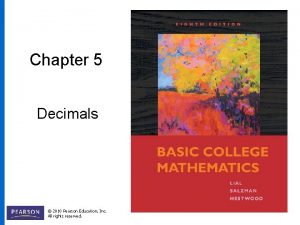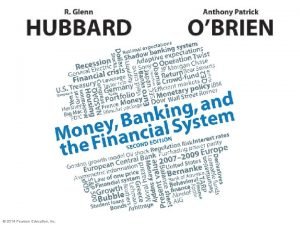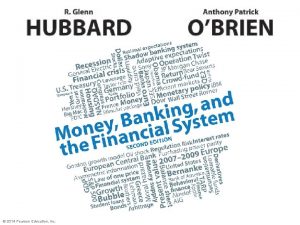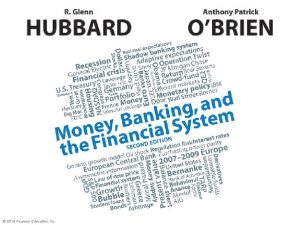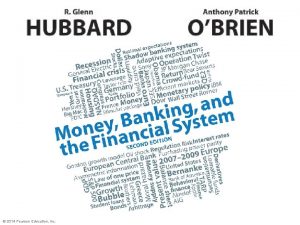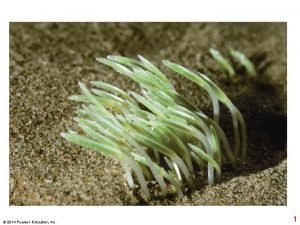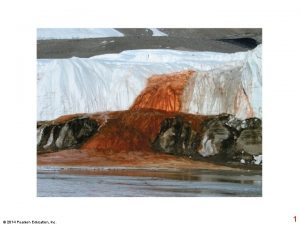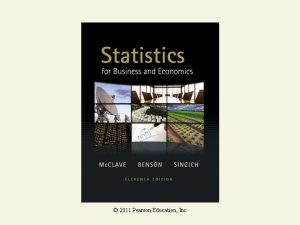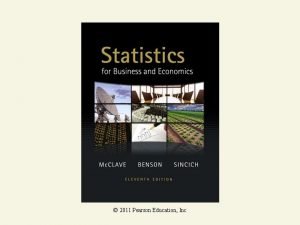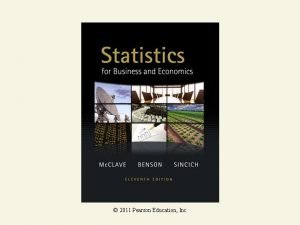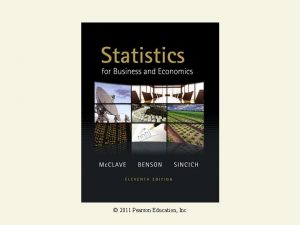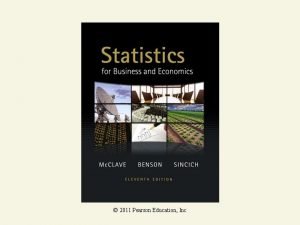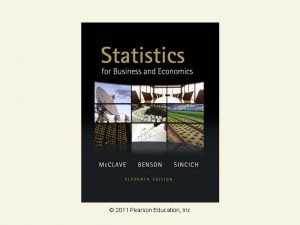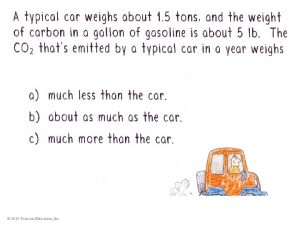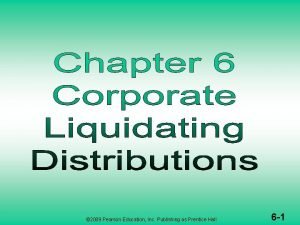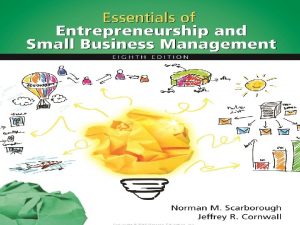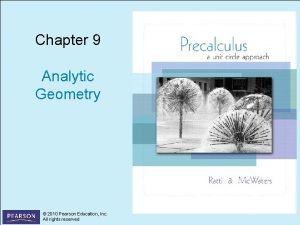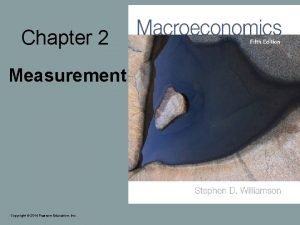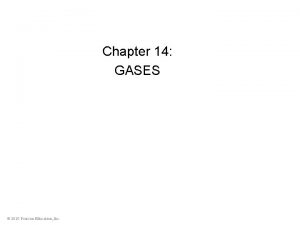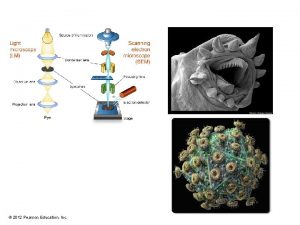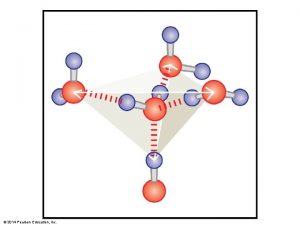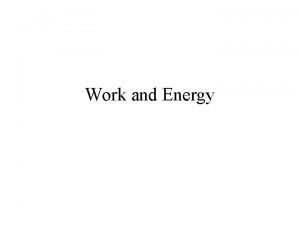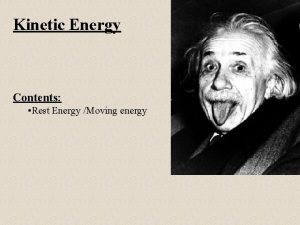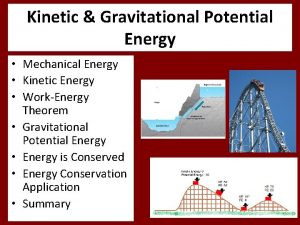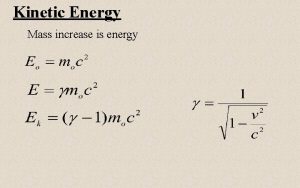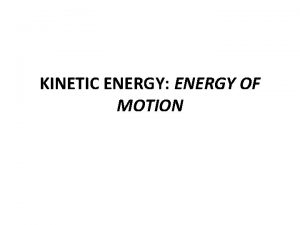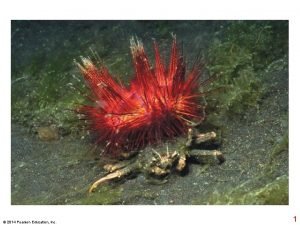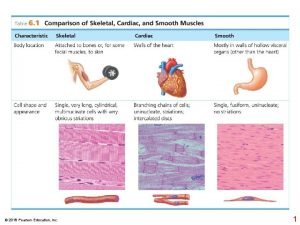Kinetic Energy 2015 Pearson Education Inc Kinetic Energy
















































































- Slides: 80

Kinetic Energy © 2015 Pearson Education, Inc.

Kinetic Energy • Energy associated with the motion of an object of mass m moving with a speed v • Scalar quantity with the same units as work • Work is related to kinetic energy Section 5. 2 Slide 10 -2

Work-Kinetic Energy Theorem (1 st time) • When work is done by a net force on an object and the only change in the object is its speed, the work done is equal to the change in the object’s kinetic energy • Speed will increase if the net work is positive • Speed will decrease if the net work is negative • CHANGE IN MECHANICAL ENERGY • Mechanical Energy: Mechanical energy is the energy that is possessed by an object due to its motion or due to its position. Mechanical energy can be either kinetic energy (energy of motion) or potential energy (stored energy of position). Objects have mechanical energy if they are in motion and/or if they are at some position relative to a zero potential energy position (for example, a brick held at a vertical position above the ground or zero height position). Section 5. 2 Slide 10 -3

Conservative and Nonconservative Forces © 2015 Pearson Education, Inc.

Types of Forces • There are two general kinds of forces • Conservative • Work and energy associated with the force can be recovered • Nonconservative • The forces are generally dissipative and work done against it cannot easily be recovered Section 5. 2 Slide 10 -14

Conservative Forces • A force is conservative if the work it does on an object moving between two points is independent of the path the objects take between the points • The work depends only upon the initial and final positions of the object Section 5. 2 Slide 10 -15

More About Conservative Forces • Examples of conservative forces include: • Gravity • Spring force • Electromagnetic forces • Potential energy is another way of looking at the work done by conservative forces Section 5. 2 Slide 10 -16

Nonconservative Forces • A force is nonconservative if the work it does on an object depends on the path taken by the object between its final and starting points. • Examples of nonconservative forces • friction, air drag, propulsive forces, normal force Section 5. 2 Slide 10 -17

Friction Depends on the Path • The blue path is shorter than the red path • The work required is less on the blue path than on the red path • Friction depends on the path and so is a non-conservative force Section 5. 2 Slide 10 -18

Work-Energy Theorem Revisited (2 nd Time) • The theorem can be expressed in terms of the work done by both conservative forces, Wc, and nonconservative forces, Wnc • Wc + Wnc = ΔKE • What is this equation saying? ? ? ? Section 5. 2 Slide 10 -19

Potential Energy © 2015 Pearson Education, Inc.

Potential Energy • Potential energy is stored energy that can be readily converted to other forms of energy, such as kinetic or thermal energy. • Forces that can store useful energy are conservative forces: • Gravity • Elastic forces (think springs) • Forces such as friction that cannot store useful energy are nonconservative forces. • Abbreviations: PE, PEg, Ug © 2015 Pearson Education, Inc. Slide 10 -21

Work and Gravitational Potential Energy • PE = mgy • • Units of Potential Energy are the same as those of Work and Kinetic Energy • Joule (J) • Wgravity is negative because…. . less energy at yf than yi (yi position is higher) Section 5. 3 Slide 10 -22

Gravitational Potential Energy • AP Class!!! Choose a the reference level where gravitational potential energy Ug = 0 since only changes in Ug matter. • Because gravity is a conservative force, gravitational potential energy depends only on the height of an object and not on the path the object took to get to that height. • Please note: Ug or PE=mgh (depends on book) Slide 10 -23

Work-Energy Theorem, (Extended 3 rd time) • The work-energy theorem can be extended to include potential energy: What do we mean by Wnc? • If other conservative forces are present, potential energy functions can be developed for them and their change in that potential energy added to the right side of the equation Section 5. 3 Slide 10 -24

Elastic Potential Energy The elastic potential energy stored in a spring is determined by the average force required to compress the spring from its equilibrium length. Could we revisit the Work Energy Model a 4 th time? ? © 2015 Pearson Education, Inc. Slide 10 -27

Work-Energy Theorem Including a Spring • Wnc = (KEf – KEi) + (PEgf – PEgi) + (PEsf – PEsi) • PEg is the gravitational potential energy • PEs is the elastic potential energy associated with a spring • PE will now be used to denote the total potential energy of the system • Remember U and PE mean the same thing…Potential Energy. . . subscript tells you what type of energy (g or s) Section 5. 4 Slide 10 -28

Question 7 • Starting from rest, a marble first rolls down a steeper hill, then down a less steep hill of the same height. For which is it going faster at the bottom? • • Faster at the bottom of the steeper hill. Faster at the bottom of the less steep hill. Same speed at the bottom of both hills. Can’t say without knowing the mass of the marble. © 2015 Pearson Education, Inc. Slide 10 -30

Question 8 • A small child slides down the four frictionless slides A–D. Rank in order, from largest to smallest, her speeds at the bottom. • • v. D > v. A > v. B > v. C v. D > v. A = v. B > v. C > v. A > v. B > v. D v. A = v. B = v. C = v. D © 2015 Pearson Education, Inc. Slide 10 -31

Question 9 • Three balls are thrown from a cliff with the same speed but at different angles. Which ball has the greatest speed just before it hits the ground? • • Ball A. Ball B. Ball C. All balls have the same speed. © 2015 Pearson Education, Inc. Slide 10 -32

Question 10 • A hockey puck sliding on smooth ice at 4 m/s comes to a 1 -m-high hill. Will it make it to the top of the hill? • • Yes. No. Can’t answer without knowing the mass of the puck. Can’t say without knowing the angle of the hill. © 2015 Pearson Education, Inc. Slide 10 -33

Question 6 • Rank in order, from largest to smallest, the gravitational potential energies of the balls. • • 1>2=4>3 1>2>3>4 3>2>4>1 3>2=4>1 © 2015 Pearson Education, Inc. Slide 10 -34

Question 7 • Starting from rest, a marble first rolls down a steeper hill, then down a less steep hill of the same height. For which is it going faster at the bottom? • • Faster at the bottom of the steeper hill. Faster at the bottom of the less steep hill. Same speed at the bottom of both hills. Can’t say without knowing the mass of the marble. © 2015 Pearson Education, Inc. Slide 10 -35

Question 8 • A small child slides down the four frictionless slides A–D. Rank in order, from largest to smallest, her speeds at the bottom. • • v. D > v. A > v. B > v. C v. D > v. A = v. B > v. C > v. A > v. B > v. D v. A = v. B = v. C = v. D © 2015 Pearson Education, Inc. Slide 10 -36

Question 9 • Three balls are thrown from a cliff with the same speed but at different angles. Which ball has the greatest speed just before it hits the ground? • • Ball A. Ball B. Ball C. All balls have the same speed. © 2015 Pearson Education, Inc. Slide 10 -37

Question 11: Pulling back on a bow An archer pulls back the string on her bow to a distance of 70 cm from its equilibrium position. To hold the string at this position takes a force of 140 N. How much elastic potential energy is stored in the bow? • A bow is an elastic material • Model it as obeying Hooke’s law, Fs = kx, where x is the distance the string is pulled back. • Use the force required to hold the string, and the distance it is pulled back, to find the bow’s spring constant k. © 2015 Pearson Education, Inc. Slide 10 -38

Question 11: Pulling back on a bow (cont. ) Hooke’s law, the spring constant is Then the elastic potential energy of the flexed bow is © 2015 Pearson Education, Inc. Slide 10 -39

Solving Energy Problems or…. . Its all about Conservation of Energy © 2015 Pearson Education, Inc.

Solving Energy Problems (Wnc=0) • Wnc = 0 (no friction issues…no nononconservative forces) • Wext = 0 (What do I mean with this statement) • Use this form to solve all Energy problems • Its all about the conservation of Energy!!!! (KE+PEg+PEs)f = (KE+PEg+PEs)i Section 5. 4 Slide 10 -41

Solving Energy Problems (Wnc≠ 0) • When nonconservative forces are present, the total mechanical energy of the system is not constant • The work done by all nonconservative forces acting on parts of a system equals the change in the mechanical energy of the system (i. e. friction losses means you go slower!!!!) = (KEf-KEi)+(PEf-PEi) +Eth • Eth=Thermal Energy…. or what is friction (More in this in a second) • Rearranging the equation: (NOTE NO WEXT THIS IS AN ISOLATED SYSTEM): (KE+PEg+PEs)f + ∆Eth= (KE+PEg+PEs)i+Wnc Section 5. 5 Slide 10 -42

Solving Energy Problems (Wnc≠ 0) • (KE+PEg+PEs)f + ∆Eth= (KE+PEg+PEs)i+Wnc • Isolated system: Assume the only change is due to ∆Eth • ∆KE - ∆PE =0 Then Wnc=∆Eth • Oh Boy Mr Herman has just confused everyone!!!!! Slide 10 -43

Here Comes the Last Rendition of the Work Energy Equation to Support Energy Problems • Key Energy Equations: • Types of Energy xx 22 • The Entire Conservation of Energy Equation with Wext • (KE+PEg+PEs)f + Wext= (KE+PEg+PEs)i+Eth Slide 10 -44

Key Equations Key Energy Equations: Types of Energy xx 22 The Entire Conservation of Energy Equation with Wext (KE+PEg+PEs)f + Wext= (KE+PEg+PEs)i+Eth Slide 10 -45

Quick Discussion Thermal Energy (or in this class “What is Friction. . . really” © 2015 Pearson Education, Inc.

What is this ∆Energy…thing!!! © 2015 Pearson Education, Inc. Slide 10 -47

Thermal Energy Thermal energy is the sum of the kinetic energy of atoms and molecules in a substance and the elastic potential energy stored in the molecular bonds between atoms. © 2015 Pearson Education, Inc. Slide 10 -48

Creating Thermal Energy Friction on a moving object does work. That work creates thermal energy. © 2015 Pearson Education, Inc. Slide 10 -49

Question 12: Creating thermal energy by rubbing A 0. 30 kg block of wood is rubbed back and forth against a wood table 30 times in each direction. The block is moved 8. 0 cm during each stroke and pressed against the table with a force of 22 N. How much thermal energy is created in this process? REMEMBER: fk = kn; the coefficient of kinetic friction for wood sliding on wood is k = 0. 20. © 2015 Pearson Education, Inc. Slide 10 -50

Question 12: Creating thermal energy by rubbing (cont. ) To find the normal force n acting on the block, we draw the free-body diagram of the figure, which shows only the vertical forces acting on the block. © 2015 Pearson Education, Inc. Slide 10 -51

Question 12: Creating thermal energy by rubbing (cont. ) • ΔEth = fk Δx, where fk = kn. • The block is not accelerating in the y-direction, so from the free-body diagram Newton’s second law gives Fy = n w F = may = 0 • Or n = w + F = mg + F = (0. 30 kg)(9. 8 m/s 2) + 22 N = 24. 9 N • The friction force is then fk = kn = (0. 20)(24. 9 N) = 4. 98 N. • The total displacement of the block is 2 30 8. 0 cm = 4. 8 m. • The thermal energy created is ΔEth = fk Δx = (4. 98 N)(4. 8 m) = 24 J Slide 10 -52

Try It Yourself: Agitating Atoms Vigorously rub a somewhat soft object such as a blackboard eraser on your desktop for about 10 seconds. If you then pass your fingers over the spot where you rubbed, you’ll feel a distinct warm area. Congratulations: You’ve just set some 100, 000, 000, 000 atoms into motion! Slide 10 -53

Lets Put this all together Using the Law of Conservation of Mechanical Energy © 2015 Pearson Education, Inc.

Conservation of Energy, cont. • Total mechanical energy is the sum of the kinetic and potential energies in the system • Other types of potential energy functions can be added to modify this equation (like Springs and rotational stuff…later in the semester) Section 5. 3 Slide 10 -55

Using the Law of Conservation of Energy • We can use the law of conservation of energy to develop a before-and-after perspective for energy conservation: ∆K + ∆Ug + ∆Us + ∆Eth = W Kf + (Ug)f + (Us)f + ∆Eth = Ki + (Ug)i + (Us)i + W • This is analogous to the before-and-after approach used with the law of conservation of momentum. • In an isolated system, W = 0 Kf + (Ug)f + (Us)f + ∆Eth = Ki + (Ug)i + (Us)i Note: If no Friction ∆Eth = 0 © 2015 Pearson Education, Inc. Slide 10 -56

Nonconservative Forces with Energy Considerations • When nonconservative forces are present, the total mechanical energy of the system is not constant • The work done by all nonconservative forces acting on parts of a system equals the change in the mechanical energy of the system What does this mean: If we do not keep adding work to overcome friction we will stop!!!! Section 5. 5 Slide 10 -57

Transferring Energy (Busy Slide) • By Work • By applying a force • Produces a displacement of the system • Heat • The process of transferring heat by microscopic collisions between atoms or molecules • For example, when a spoon rests in a cup of coffee, the spoon becomes hot because some of the KE of the molecules in the coffee is transferred to the molecules of the spoon as internal energy • Mechanical Waves • A disturbance propagates through a medium • Examples include sound, water, seismic • Electrical transmission • Transfer by means of electrical current • This is how energy enters any electrical device • Electromagnetic radiation • Any form of electromagnetic waves • Light, microwaves, radio waves • Examples • Cooking something in your microwave oven • Light energy traveling from the Sun to the Earth Slide 10 -58

Notes About Conservation of Energy • We can neither create nor destroy energy • Another way of saying energy is conserved • If the total energy of the system does not remain constant, the energy must have crossed the boundary by some mechanism • Applies to areas other than physics Section 5. 5 Slide 10 -59

Energy Bar Graph Sample Copyright © 2007, Pearson Education, Inc. , Publishing as Pearson Addison-Wesley.

Energy Bar Chart Example 1 Copyright © 2007, Pearson Education, Inc. , Publishing as Pearson Addison-Wesley.

Energy Bar Chart Example II Copyright © 2007, Pearson Education, Inc. , Publishing as Pearson Addison-Wesley.

Energy Bar Chart Example III Previous slide Copyright © 2007, Pearson Education, Inc. , Publishing as Pearson Addison-Wesley.

Question 13 A spring-loaded gun shoots a plastic ball with a launch speed of 2. 0 m/s. If the spring is compressed twice as far, the ball’s launch speed will be A. B. C. D. E. 1. 0 m/s 2. 8 m/s 4. 0 m/s 16. 0 m/s © 2015 Pearson Education, Inc. Slide 10 -64

Question 14 A spring-loaded gun shoots a plastic ball with a launch speed of 2. 0 m/s. If the spring is replaced with a new spring having twice the spring constant (but still compressed the same distance), the ball’s launch speed will be A. B. C. D. E. 1. 0 m/s 2. 8 m/s 4. 0 m/s 16. 0 m/s © 2015 Pearson Education, Inc. Slide 10 -65

Question 13 A spring-loaded gun shoots a plastic ball with a launch speed of 2. 0 m/s. If the spring is compressed twice as far, the ball’s launch speed will be A. B. C. D. E. 1. 0 m/s 2. 8 m/s 4. 0 m/s 16. 0 m/s © 2015 Pearson Education, Inc. Conservation of energy: Double x double v Slide 10 -66

Question 14 A spring-loaded gun shoots a plastic ball with a launch speed of 2. 0 m/s. If the spring is replaced with a new spring having twice the spring constant (but still compressed the same distance), the ball’s launch speed will be A. B. C. D. E. 1. 0 m/s 2. 8 m/s 4. 0 m/s 16. 0 m/s © 2015 Pearson Education, Inc. Conservation of energy: Double k increase v by square root of 2 Slide 10 -67

Question 15 A car sits at rest at the top of a hill. A small push sends it rolling down the hill. After its height has dropped by 5. 0 m, it is moving at a good clip. Write down the equation for conservation of energy, noting the choice of system, the initial and final states, and what energy transformation has taken place. © 2015 Pearson Education, Inc. Slide 10 -68

Question 16: Speed at the bottom of a water slide While at the county fair, Katie tries the water slide, whose shape is shown in the figure. The starting point is 9. 0 m above the ground. She pushes off with an initial speed of 2. 0 m/s. If the slide is frictionless, how fast will Katie be traveling at the bottom? Draw and Energy bar graph and a picture. Use the Energy Worksheet. © 2015 Pearson Education, Inc. Slide 10 -69

Question 16: Speed at the bottom of a water slide (cont. ) Conservation of mechanical energy gives Kf + (Ug)f = Ki + (Ug)i or © 2015 Pearson Education, Inc. Slide 10 -70

Question 16: Speed at the bottom of a water slide (cont. ) Taking yf = 0 m, we have which we can solve to get Note: • The shape of the slide does not matter because gravitational potential energy depends only on the height above a reference level. • Final velocity does not care about the mass of the object!!! Slide 10 -71

Question 17: Pulling a bike trailer Monica pulls her daughter Jessie in a bike trailer. The trailer and Jessie together have a mass of 25 kg. Monica starts up a 100 -m-long slope that’s 4. 0 m high. On the slope, Monica’s bike pulls on the trailer with a constant force of 8. 0 N. They start out at the bottom of the slope with a speed of 5. 3 m/s. What is their speed at the top of the slope? © 2015 Pearson Education, Inc. Slide 10 -72

Question 17: Pulling a bike trailer (cont. ) • Take Jessie and the trailer as the system • Monica’s bike is applying a force to the system as it moves through a displacement; that is, Monica’s bike is doing work on the system. • Need to use the full version of the Conservation of Energy equation including the work term W. • Draw and Energy Bar Graph, a picture, use the worksheet!!! Slide 10 -73

Question 17: Pulling a bike trailer (cont. ) No friction, so that ΔEth = 0, then Equation Conservation of Energy Equation is Kf + (Ug)f = Ki + (Ug)i + W or © 2015 Pearson Education, Inc. Slide 10 -74

Question 17: Pulling a bike trailer (cont. ) Taking yi = 0 m and writing W = Fd, we can solve for the final speed: vf = 3. 7 m/s. Note: Work is a positive quantity because the force is in the same direction as the displacement. ASSESS A speed of 3. 7 m/s—about 8 mph—seems reasonable for a bicycle’s speed. Jessie’s final speed is less than her initial speed, indicating that the uphill force of Monica’s bike on the trailer is less than the downhill component of gravity. Slide 10 -75

Energy and Its Conservation Text: p. 304 © 2015 Pearson Education, Inc. Slide 10 -76

Energy and Its Conservation Text: p. 304 © 2015 Pearson Education, Inc. Slide 10 -77

Energy in Collisions Conservation of Momentum AND Conservation of Energy Together as one!!! © 2015 Pearson Education, Inc.

Energy in Collisions • A collision in which the colliding objects stick together and then move with a common final velocity is a perfectly inelastic collision. • A collision in which mechanical energy is conserved is called a perfectly elastic collision. • While momentum is conserved in all collisions, mechanical energy is only conserved in a perfectly elastic collision. • In an inelastic collision, some mechanical energy is converted to thermal energy. (This does not mean Energy is not conserved) © 2015 Pearson Education, Inc. Slide 10 -79

Question 18: Energy transformations in a perfectly inelastic collision The figure shows two train cars that move toward each other, collide, and couple together. Last Chapter we used conservation of momentum to find the final velocity shown in the figure from the given initial velocities. How much thermal energy is created in this collision? © 2015 Pearson Education, Inc. Slide 10 -80

Quesiton 18: Energy transformations in a perfectly inelastic collision (cont. ) Choose our system to be the two cars. Track is horizontal, there is no change in potential energy. The conservation of energy equation for this problem…. . Kf + ΔEth = Ki. The total energy before the collision must equal the total energy afterward, but the mechanical energies need not be equal. © 2015 Pearson Education, Inc. Slide 10 -81

Question 18: Energy transformations in a perfectly inelastic collision (cont. ) SOLVE The initial kinetic energy is Because the cars stick together and move as a single object with mass m 1 + m 2, the final kinetic energy is © 2015 Pearson Education, Inc. Slide 10 -82

Question 18: Energy transformations in a perfectly inelastic collision (cont. ) ΔEth = Ki Kf = 4. 7 104 J 1900 J = 4. 5 104 J This amount of the initial kinetic energy is transformed into thermal energy during the impact of the collision. FACT OF LIFE: About 96% of the initial kinetic energy is transformed into thermal energy. This is typical of many real-world collisions. © 2015 Pearson Education, Inc. Slide 10 -83

Elastic Collisions Elastic collisions obey conservation of momentum and conservation of mechanical energy. These problems can get hard…sometimes the problem requires 2 equations because you have 2 unknowns. . . its why we skipped elastic equations in the Momentum Chapter Momentum: Energy: © 2015 Pearson Education, Inc. Slide 10 -84

Ealastic Collisions • Here is what you get when you take those two equations and put them together (I am not going to spend the time. . whole bunch of Algebra). © 2015 Pearson Education, Inc. Slide 10 -85

Question 19: Velocities in an air hockey collision On an air hockey table, a moving puck, traveling to the right at 2. 3 m/s, makes a head-on collision with an identical puck at rest. What is the final velocity of each puck? © 2015 Pearson Education, Inc. Slide 10 -86

Question 19: Velocities in an air hockey collision (cont. ) Final velocities are shown in the picture, but we don’t really know yet which way the pucks will move. Because one puck was initially at rest, The pucks are identical, so we have m 1 = m 2 = m. © 2015 Pearson Education, Inc. Slide 10 -87

Example 10. 16 Velocities in an air hockey collision (cont. ) PLUG AND CHUG THE EQUATIONS: with m 1 = m 2 = m to get and v The incoming puck stops dead, and the initially stationary puck goes off with the same velocity that the incoming one had. © 2015 Pearson Education, Inc. Slide 10 -88

Example Protecting your head (Quick Discussion to give you a feeling why Concussions are and Issue and why they occur A bike helmet—basically a shell of hard, crushable foam—is tested by being strapped onto a 5. 0 kg headform and dropped from a height of 2. 0 m onto a hard anvil. What force is encountered by the headform if the impact crushes the foam by 3. 0 cm? • We the work-energy equation to calculate the force on the headform. • We’ll choose the headform and the earth to be the system; the foam in the helmet is part of the environment. We make this choice so that the force on the headform due to the foam is an external force that does work W on the headform. Slide 10 -89

Example 10. 17 Protecting your head (cont. ) Before-and-after visual overview of the bike helmet test © 2015 Pearson Education, Inc. Slide 10 -90

Example: Protecting your head (cont. ) • The headform starts at rest, speeds up as it falls, then returns to rest during the impact. • Overall, then, Kf = Ki. Furthermore, ΔEth = 0 because there’s no friction to increase thermal energy. Only the gravitational potential energy changes, so the work-energy equation is • (Ug)f (Ug)i = W • The upward force of the foam on the headform is opposite the downward displacement of the headform. • The work done is negative: W = Fd, • Assumed the force is constant. • Using this result in the work-energy equation and solving for F, we find © 2015 Pearson Education, Inc. Slide 10 -91

Example: Protecting your head (cont. ) Taking our reference height to be y = 0 m at the anvil, we have (Ug)f = 0. We’re left with (Ug)i = mgyi, so This is the force that acts on the head to bring it to a halt in 3. 0 cm. More important from the perspective of possible brain injury is the head’s acceleration: ASSESS The accepted threshold for serious brain injury is around 300 g, so this helmet would protect the rider in all but the most serious accidents. Without the helmet, the rider’s head would come to a stop in a much shorter distance and thus be subjected to a much larger acceleration. © 2015 Pearson Education, Inc. Slide 10 -92
 2015 pearson education inc
2015 pearson education inc Copyright pearson education inc
Copyright pearson education inc 2015 pearson education inc
2015 pearson education inc 2015 pearson education inc
2015 pearson education inc 2015 pearson education inc
2015 pearson education inc 2015 pearson education inc
2015 pearson education inc Pearson education ltd 2015
Pearson education ltd 2015 2015 pearson education inc
2015 pearson education inc 2015 pearson education inc
2015 pearson education inc 2015 pearson education inc
2015 pearson education inc Pearson education, inc. publishing as prentice hall
Pearson education, inc. publishing as prentice hall 2011 pearson education inc
2011 pearson education inc Pearson education inc publishing as pearson prentice hall
Pearson education inc publishing as pearson prentice hall Pearson 2012
Pearson 2012 Pearson education inc publishing as pearson prentice hall
Pearson education inc publishing as pearson prentice hall Pearson education limited 2015
Pearson education limited 2015 Formal planning may create rigidity.
Formal planning may create rigidity. Pearson education limited 2015
Pearson education limited 2015 Pearson education limited 2015
Pearson education limited 2015 Pearson education limited 2015
Pearson education limited 2015 Pearson education limited 2015
Pearson education limited 2015 Pearson education limited 2015
Pearson education limited 2015 Pearson education limited 2015
Pearson education limited 2015 Pearson education limited 2015
Pearson education limited 2015 Copyright pearson education inc
Copyright pearson education inc 2017 pearson education inc
2017 pearson education inc Copyright pearson education inc
Copyright pearson education inc 2017 pearson education inc
2017 pearson education inc 2017 pearson education inc
2017 pearson education inc 2017 pearson education inc
2017 pearson education inc 2017 pearson education inc
2017 pearson education inc Pearson education inc 4
Pearson education inc 4 2014 pearson education inc
2014 pearson education inc 2013 pearson education inc
2013 pearson education inc 2013 pearson education inc
2013 pearson education inc Performance gap
Performance gap 2013 pearson education inc
2013 pearson education inc Pearson education inc. publishing as prentice hall
Pearson education inc. publishing as prentice hall 2012 pearson education inc
2012 pearson education inc 2012 pearson education inc
2012 pearson education inc 2010 pearson education inc
2010 pearson education inc Copyright 2010 pearson education inc
Copyright 2010 pearson education inc 2009 pearson education inc
2009 pearson education inc 2016 pearson education inc
2016 pearson education inc Decimal in words example
Decimal in words example 2010 pearson education inc answers
2010 pearson education inc answers 2014 pearson education inc
2014 pearson education inc 2014 pearson education inc
2014 pearson education inc 2014 pearson education inc
2014 pearson education inc 2014 pearson education inc
2014 pearson education inc 2014 pearson education inc
2014 pearson education inc 2014 pearson education inc
2014 pearson education inc 2014 pearson education inc
2014 pearson education inc 2012 pearson education inc
2012 pearson education inc 2011 pearson education inc
2011 pearson education inc 2011 pearson education inc
2011 pearson education inc 2011 pearson education inc
2011 pearson education inc Friedman rank test
Friedman rank test 2011 pearson education inc
2011 pearson education inc 2011 pearson education inc
2011 pearson education inc 2010 pearson education inc answers
2010 pearson education inc answers 2009 pearson education inc
2009 pearson education inc 2009 pearson education inc
2009 pearson education inc 2016 pearson education inc
2016 pearson education inc 2017 pearson education inc
2017 pearson education inc Pearson education inc 1
Pearson education inc 1 2016 pearson education inc
2016 pearson education inc 2016 pearson education inc
2016 pearson education inc 2014 pearson education inc
2014 pearson education inc 2013 pearson education inc
2013 pearson education inc 2013 pearson education inc
2013 pearson education inc 2009 pearson education inc
2009 pearson education inc Copyright 2009 pearson education inc
Copyright 2009 pearson education inc Pearson education
Pearson education 2008 pearson education inc
2008 pearson education inc 2008 pearson education inc
2008 pearson education inc 2010 pearson education inc answers
2010 pearson education inc answers 2014 pearson education inc
2014 pearson education inc 2014 pearson education inc
2014 pearson education inc 2010 pearson education inc answers
2010 pearson education inc answers 2016 pearson education inc
2016 pearson education inc



